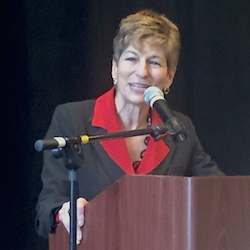
A model that integrates onsite primary care, pharmacy and lab services with social supports and residential care may make senior living communities more attractive to payers and investors because it improves outcomes and saves money, according to new research presented Wednesday at the National Investment Center for Seniors Housing & Care’s 2017 Spring Investment Forum in San Diego.
The results of an independent analysis of Juniper Communities’ Connect4Life model found that the program resulted in 50% lower inpatient hospitalization rates, more than 80% lower readmission rates and 15% lower ED use for residents compared with Medicare beneficiaries who did not live in Juniper communities but had similar conditions, Lynne Katzmann, Ph.D., founder and president of the company, said Wednesday at a press conference at the NIC meeting. Residents also ended up using fewer services than did a similar population in seniors housing.
The Bloomfield, NJ-based company, which has 22 properties in four states, began developing the model in 2012 “to extend length of stay for existing residents and to differentiate our product from our competitors so that ultimately we could increase our market share,” Katzmann said. As is the case with many other long-time senior living operators, she said, Juniper was experiencing increasing acuity levels among residents as they aged in place.
Model is ‘high-tech, high-touch’
“So we’ve effectively co-located ancillary services in our buildings” Katzmann said. But what differentiates Juniper from some other companies that might think they operate under a similar model, she said, is that “we co-locate the services, and we demand participation in a particular way. We’ve got non-negotiables. But most importantly, we integrate what we do and what they do with a series of integrated systems.”
A key part of the series, Katzmann said, is that everyone involved uses the same electronic health records system to provide real-time data, a common communications platform and outcomes measurement. “If you don’t have an EHR that allows you to share information across your continuum of providers on-site, this won’t work,” she said.
Also critical is having someone on-site to connect ancillary service providers, community staff, and residents and families, Katzmann said. At Juniper, that person is what the company calls a medical concierge, or emcee, usually a certified medical assistant. “We’ve found that that one-on-one approach is as important as our EHR,” she said.
The approach adds up to what Katzmann calls “high-tech, high-touch,” and she said that the new analysis proves that Juniper has “cracked the code” for addressing the challenges that operators can face when trying to manage the multiple chronic conditions that frail seniors often have.
Analysis shows potential
The analysis, conducted by independent researcher Anne Tumlinson, compared Connect4Life results to data in the 2012 Medicare Beneficiaries Survey for similarly disabled and cognitively affected Medicare populations living in the greater community, as well as those living in seniors housing that does not have integrated healthcare programs. Although Juniper’s residents were older and more cognitively impaired than the overall Medicare population, the Connect4Life model consistently produced better results, Tumlinson found.
“The findings clearly suggest that integrated seniors housing services programs like Juniper Communities’ Connect4Life have great potential to reduce the cost of care to high-need, high-cost Medicare beneficiaries,” Tumlinson said. “This is incredibly important news for accountable care and managed care organizations, who should be working with innovative seniors housing providers to manage population health. Juniper’sConnect4Life model appears able to outperform fee-for-service Medicare for similarly frail beneficiaries living in the community or other seniors housing.”
Partnerships important
The Juniper study findings, which exceeded the company’s expectations, reinforce the theme of this year’s NIC spring meeting, which is “Unlocking New Value Through Senior Care Collaboration,” Katzmann said.
“Seniors housing is one solution for population management. We can be effective with the high-cost, high-needs folks,” she said. “Partnership is critical to our individual and collective future success. Real estate and operators … need to be interdependent, and we must break down the silos.”
“We’re not talking about medicalizing private-pay seniors housing, NIC CEO Robert G. Kramer said at the press conference. “What we’re talking about is recognizing that when you create a setting where the residents’ needs can be fully addressed, you’re going to produce better quality-of-life outcomes. You’re also going to bend the cost curve. You’re going to provide better healthcare outcomes, and you’re going to do it in a setting where they live and function every day rather than sending them off to the hospital or even to the doctor’s office or the medical office building.”
This year’s conference has record attendance of more than 1,500 leaders in senior living, skilled nursing, finance and other sectors, Kramer said.
The meeting continues through Friday.
Photo by John O’Connor.



